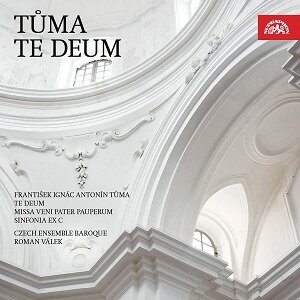
František Tůma (1704-1774)
Te Deum (1745)
Sinfonia ex C (c.1770s?)
Missa Veni Pater pauperum (1736)
Czech Ensemble Baroque, Orchestra and Choir/Roman Válek
rec. 2022, St Michael’s Church, Znojmo, Czech Republic
No texts
SUPRAPHON SU4315-2 [54]
František Ignác Antonín Tůma was born in East Bohemia in 1704 and his compositions reflect the divisions, fault lines and transitions between the late Baroque and the Galant style. Though he composed for instrumental forces he is best remembered for his sacred music. After education in Prague – apparently, he performed at the coronation of Charles VI in the city – he gravitated to Vienna where under the benevolent tutelage of Count Kinsky he was encouraged to study with Fux. After Kinsky’s death he received a handsome pension which allowed him to freelance. Much about his early days, though, remains unknown and for all his erudition, note writer Vlastimil Tichý can’t avoid those biographical crutches ‘probably’ and ‘in all likelihood’.
In 1736 he wrote the Missa Veni Pater pauperum for the Schottenstift, a Benedictine abbey in Vienna, and it seems to have been performed multiple times in the 1740s and 1750s. It’s a Festive setting of the Mass Ordinary and reveals strongly the influence of Fux in its polyphonic mastery and freshness. Czech Ensemble Baroque lines up 6-1-1 and winds, brass, organ and timpani. The vocal soloists are drawn from the Choir of twelve members. The work calls for two sopranos (Romana Kružiková and Pavla Radostová) and the former’s expressive singing of the Christe eleison is valuable. Tůma allows two trumpets to overlap in the Gloria and uses the brass soloistically and colouristically or to provide obligati for the solo singers in Qui tollis. Festive grandeur is at its peak in Qui sedes and brass recur as active and dramatic agents in Et incarnatus, a movement full of polyphonic drive. In the end it’s a work of small-scaled movements reflecting compressed but by no means limited expressive material. Its polyphony extends to the final Dona nobis pacem where a satisfying conclusion is reached.
Just under a decade later, amidst a slew of other compositions, Tůma wrote his Te Deum, a compact and festive ten-minute work. Tůma cannily reserves the full choir for salient moments of heightened expressive bravura, say in the very brief Tu devicto mortis. It allows a moment of buttressing power in this otherwise taut setting where he makes much from small motifs and devices. His use of the trombones is canny and the string figuration in Aeterna fac drives the music toward a fine, sweeping end.
Tůma worked on a relatively small canvass employing succinct devices of the Baroque but increasingly he absorbed elements of Galant symphonism. The Sinfonia ex C is undated but it’s clearly a late-ish work as it’s fashioned after the Viennese symphonies or sinfonias of the day. Confidently laid out in four movements it allows the Czech Baroque Ensemble full unfettered rein and they exude buoyancy in their performance but in the context of light articulation and incision, attentive to the relatively modest demands of the music. This symphonic element of Tůma’s music-making can be contextualised when listening to the Bohemian Baroque series on Alto which includes music by, inter alia, Benda, Bárta, Richter, Stamic, Vaňhal, Brixi and others.
The acoustic in St Michael’s Church in the town of Znojmo is characteristically ample but confers a flattering bloom to the sound. These are attentive performances, well-shaped by Roman Válek – who, with the same forces, recorded the Requiem of Franz Xaver Richter a number of years ago for Supraphon. Tůma is not as well-known as Richter but he exemplifies the professionalism and technical competence of members of the Bohemian diaspora in the eighteenth century.
Jonathan Woolf
Help us financially by purchasing from





















